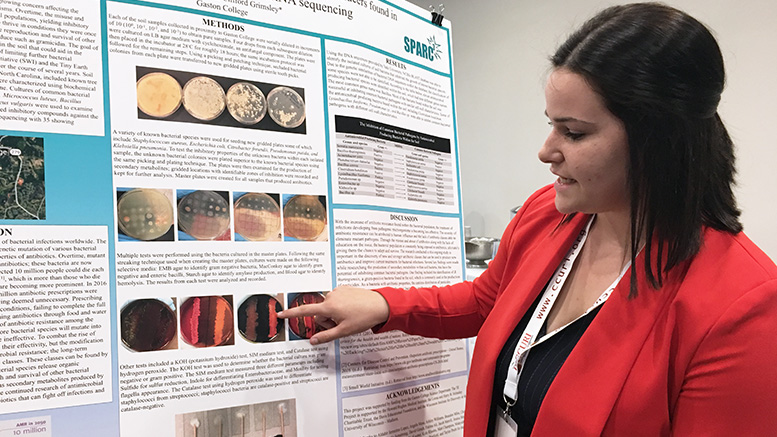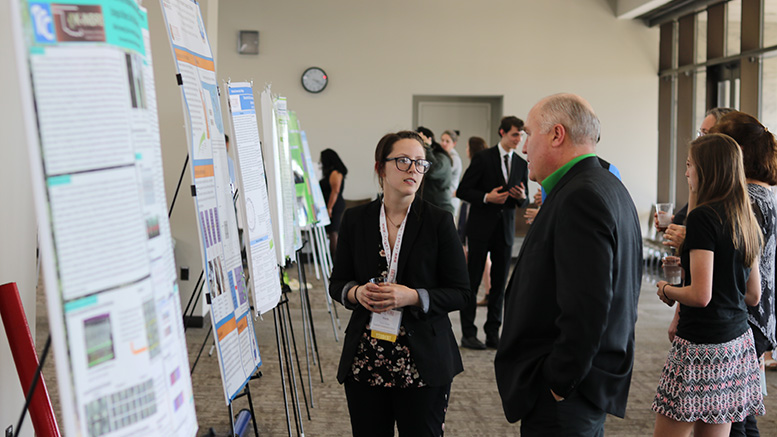At the national poster session of the Community College Undergraduate Research Initiative (CCURI) last week, 47 former and current community college students talked knowledgeably and intently about their research methods and findings.
James Hewlett, CCURI’s executive director, considers the national and regional student poster sessions the “signature events” for the Finger Lakes Community College (FLCC)-based program that offers professional development and curricula to help community college faculty incorporate research experiences into their teaching.
Hewlett, a professor of science and technology and director of biotechnology/biomanufacturing at the New York college, began CCURI in 2005 with a National Science Foundation-funded pilot project. Subsequently, larger NSF grants have helped CCURI grow into a network of 125 two-year colleges. Through its partner and affiliated institutions in 2017-2018, CURRI facilitated the participation of 5,645 students in authentic research projects across the country.
A shot in the arm
Prior to the poster session, Hewlett recounted that the impetus for CCURI came in 2003 when he and two students helped a biologist collect blood samples from juvenile red-tailed hawks.
“It was a really cool project,” Hewlett said.
The experience of gathering data in the field and guiding the students as they tested the blood samples in the college’s lab invigorated his approach to teaching. When other professors asked him what he had done to prompt the two students to work more diligently in their other courses, Hewlett took those comments as further evidence that doing research is a transformative pedagogy.
Since then Hewlett has become a leading advocate for undergraduate research at community colleges. CCURI’s resources help faculty add research experiences via courses, summer internships and full academic programs.
A chance to network
The event on May 2 at the Hart Senate Office Building exhibition hall in Washington, D.C., provided students not only a chance to show their posters but also to network. They began their networking earlier in the day when they visited their home states’ congressional offices. There they told aides, and in some instances lawmakers, about their research projects and expressed appreciation for the NSF’s support of CCURI.
During the past 14 years, FLCC has received NSF grants for CCURI ranging from $27,000 to $3.5 million. The four NSF programs that have provided support to CCURI are Course, Curriculum and Laboratory Improvement (CCLI), Transforming Undergraduate Education in Science (TUES), Improving Undergraduate STEM Education (IUSE) and Advanced Technological Education (ATE).
The day-long event not only further inspired the students, but Hewlett as well.
“When I leave these events, I go back super energized. It’s the students and their work that make me think it’s totally worth it,” he said.
A look at the projects
The projects featured on the posters included a pure mathematics project at Everett Community College (Washington), a six-year wildlife study conducted by dozens of students at Moreno Valley College (California), and two students’ examinations of plant extracts for cancer treatment at Muskegon Community College (Michigan).
During interviews, students’ earnestness, intellectual curiosity and clear-eyed plans to pursue careers in science, technology, engineering, or math permeated their responses.
Emily Sample, a freshman at Redlands Community College (Oklahoma), described flipping over rocks in streams to gather freshwater sponge cells in 21 locations. In the college’s lab she tallied info on 15 water parameters for each sample to test theories about what affects the sponges’ viability for a DNA bar-coding project. This project is one of several that CCURI developed as a low-cost ways for faculty to drop research experiences into existing science courses.
“I want to do more research lab work. I like stuff like this. But I want to use this data and the information it taught me to apply it to research for medical needs. That’s what I’m really passionate about,” she said.
Related story: Exploring research experiences at community colleges
Chanele Rodriguez summarized multiple semesters of research on the energy storage potential of ionic liquids that she and other Queensborough Community College students did as interns at Brookhaven National Laboratory. Rodriquez is currently enrolled in a baccalaureate civil engineering program at New York University where she learned that ionic liquids are also being studied for non-destructive testing. So, she’s optimistic that her community college research may have practical implications during her career.
Among the youngest presenters was Ingrid Phillips, who will receive a high school diploma and associate degree from Everett Community College in a few weeks. She and another student in the college’s Ocean Research College Academy created the fast-oceanographic automated measurement tool in collaboration with Gravity Consulting to improve their collection of surface water samples in the estuary where the Snohomish River empties into Puget Sound.
“I was really interested in looking at this because we have this island here — Jetty Island — and I was really curious how the freshwater would behave,” Phillips said.
Discovering that the river flows mainly west at ebb tide led to her ongoing study of the impact of nutrients, heavy metals and other toxins carried by the river into the island’s field grasses. She hopes to continue exploring the interaction between river flows and tidal patterns as an engineering student at the University of Washington.

Autumn Allen explains the work that she and other microbiology students at Gaston College have done during the past 15 semesters as part of two national efforts to improve antibiotics. (Photo: Madeline Patton)
Antibiotic resistant bacteria are the focus of two distinct projects detailed on posters presented by Mideyshka Vazquez and Autumn Allen of Gaston College (North Carolina). Both women are recipients of scholarships the college provided from the grant it received from the NSF Scholarships in Science, Technology, Engineering and Mathematics Program (S-STEM).
It was announced last week that Megan Mitchem, another of Gaston’s S-STEM scholars, has been awarded the prestigious Goldwater Scholarship for her research on ways to reduce phosphorus in the food or beverages that kidney patients consume. The idea for Mitchem’s independent research came from her work as a dialysis technician, according to Melissa Armstrong, chair of math and science at Gaston. Armstrong mentored Mitchem and accompanied Vazquez and Allen to the poster session.
Because Gaston College offers research opportunities at multiple course levels and in nearly every discipline, Vazquez’s investigation of the antibacterial properties of fuggle hops in Organic Chemistry II was her third undergraduate research experience. All those research experiences have encouraged her to become a pharmacist.
“Things I have learned by conducting research I will be able to replicate them and use when I go (in) to pharmacy,” she said.
Serving a public good
Allen’s poster summarized the results of soil tests conducted by her and other microbiology students during the past 15 semesters for the Small World Initiative and Tiny Earth projects. Both of those national initiatives engage students in the search for antimicrobial-producing bacteria to help scientists improve antibiotic medications.
Calling herself a “bio-nerd,” Allen has discovered that the “what-ifs” of conducting research appeal to her.
“I feel like it just activated a different part of my brain. It made me interested in something I didn’t know I was capable of,” she said.
A few semesters back, Vazquez and Allen were students in separate sections of Armstrong’s general chemistry course. Since 2012, Armstrong has devoted about 15 percent of the introductory course’s labs to water quality research that involves students testing their homes’ tap water.
“Students are very engaged in that. They want to know what’s in their water,” she said, adding that the open-endedness of the assignments hold everyone’s attention.
“I don’t know what they are going to find, and they don’t know what they are going to find. Although they’ve got protocols that they follow, nobody knows what they are going to find, and sometimes we have found terrifyingly high lead levels in people’s water supplies in their homes,” Armstrong said.
If lead levels are high when students re-test the water, she directs them to the health department for additional testing.

